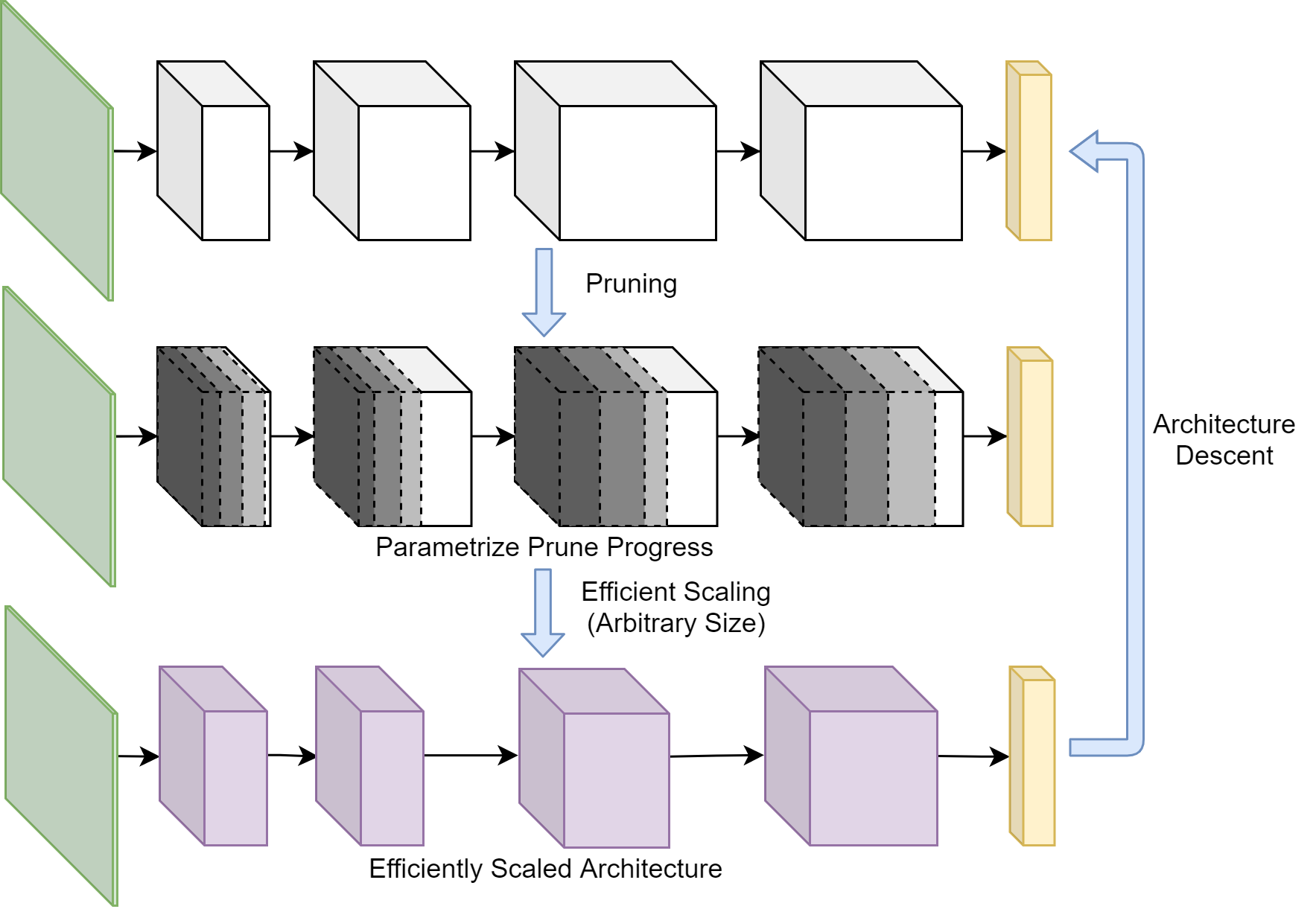This repository is the original implementation and contains required scripts to reproduce results from our paper NeuralScale: Efficient Scaling of Neurons for Resource-Constrained Deep Neural Networks that has been accepted to CVPR 2020 (oral).
Authors: Eugene Lee and Chen-Yi Lee
Clone this repo.
git clone https://github.com/eugenelet/NeuralScale.git
cd NeuralScale/All experiments are run on a single NVIDIA GTX1080Ti GPU.
The code was tested with python3.6 the following software versions:
| Software | version |
|---|---|
| cuDNN | v7500 |
| Pytorch | 1.0.1.post2 |
| CUDA | v10.0 |
Data for CIFAR10 and CIFAR100 will be automatically downloaded upon the execution of scripts that require it.
Examples that runs on TinyImageNet requires a manual download from here.
Prepare dataset by running the script below: (source)
unzip tiny-imagenet-200.zip
rm -r ./tiny-imagenet-200/test
python3 val_format.py
Edit directory locations in val_format.py in accordance on where TinyImageNet is stored in your system.
Models with their accompanied datasets to run:
| Models | Dataset |
|---|---|
| VGG11 | CIFAR10, CIFAR100 |
| ResNet18 | CIFAR10, CIFAR100, TinyImageNet |
| MobileNetV2 | CIFAR10, CIFAR100, TinyImageNet |
All examples below are based on VGG11 using CIFAR100 and MobileNetV2 using TinyImageNet respectively.
To search for configuration using architecture descent, run
python3 architecture_descent.py --model vgg --dataset CIFAR100 --save filename
python3 imagenet_architecture_descent.py --model mobilenetv2 --dataset tinyimagenet --save filename
To prune (using Taylor-FO) until 50% of total filters are remaining, run (for comparison with MorphNet)
python3 architecture_descent.py --model vgg --dataset CIFAR100 --save filename --morph
python3 imagenet_architecture_descent.py --model mobilenetv2 --dataset tinyimagenet --save filename --morph
To train from scratch using the searched configurations using different scaling ratios, run
python3 ratio_swipe.py --model vgg --dataset CIFAR100 --prune_fname filename --save save_filename_0
python3 imagenet_ratio_swipe.py --model mobilenetv2 --dataset tinyimagenet --prune_fname filename --save save_filename_0
Note that the number at the end (save_filename_X) is helpful for obtaining the mean across several simulations. In our experiments X ranges from 0 to 4.
To train a model with configuration found using MorphNet that uses Taylor-FO as a pruning method, run
python3 ratio_swipe.py --model vgg --dataset CIFAR100 --morph --save save_filename_0
python3 imagenet_ratio_swipe.py --model mobilenetv2 --dataset tinyimagenet --morph --save save_filename_0
If a new configuration is found, changes has to be done manually by editing the file ratio_swipe.py or imagenet_ratio_swipe.py. Overwrite the configuration found right after the variable pruned_filters for the corresponding Model-Dataset pair.
To plot trained results, run
python3 plot_ratio.py --model vgg --dataset CIFAR100
Before running, edit the filename in accordance to the filename you saved. It's advisable to run for 5 independent simulations to get a fair comparison. Simulations based on other scaling methods are stored in this repository in the directory saved_plots/model_name where model_name can be vgg, resnet18 or mobilenetv2 depending on the desired model. Using VGG11 on CIFAR100 as an example, the plots are stored as follows (default):
| Scaling Method | Filename |
|---|---|
| Uniform Scaling (Baseline) | ./saved_plots/resnet18/vgg_uni_c100_[0~4] |
| Pruning based on weight magnitude | ./saved_plots/resnet18/vgg_norm_c100_[0~4] |
| MorphNet (Taylor-FO) | ./saved_plots/resnet18/vgg_pruned_c100_[0~4] |
| NeuralScale (Iteration = 1) | ./saved_plots/resnet18/vgg_10_eff_c100_early_[0~4] |
| NeuralScale (Iteration = 15) | ./saved_plots/resnet18/vgg_10_eff_c100_late_[0~4] |
Below are accuracies obtained using different methods:
| VGG11-CIFAR10 | VGG11-CIFAR100 |
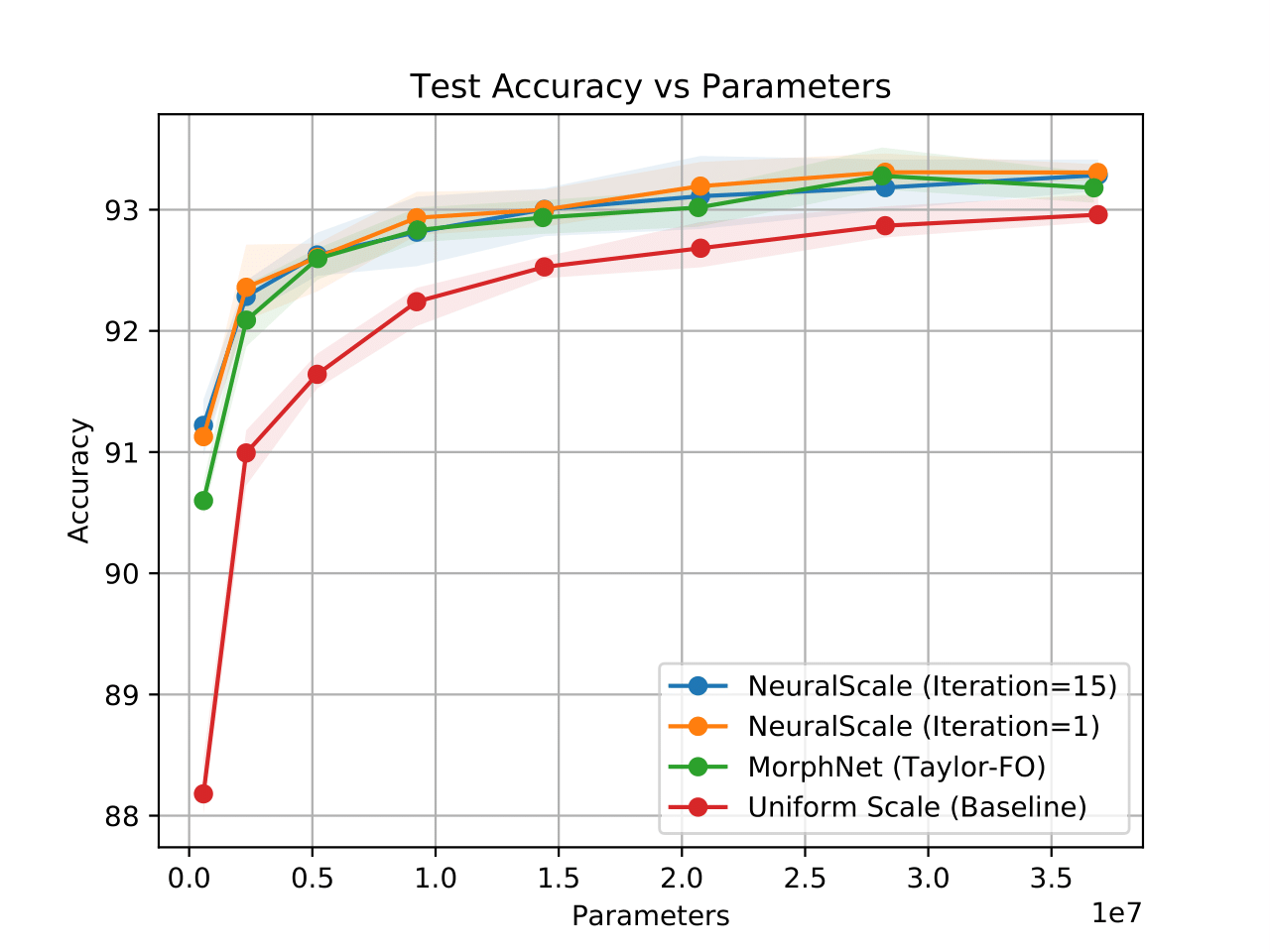 |
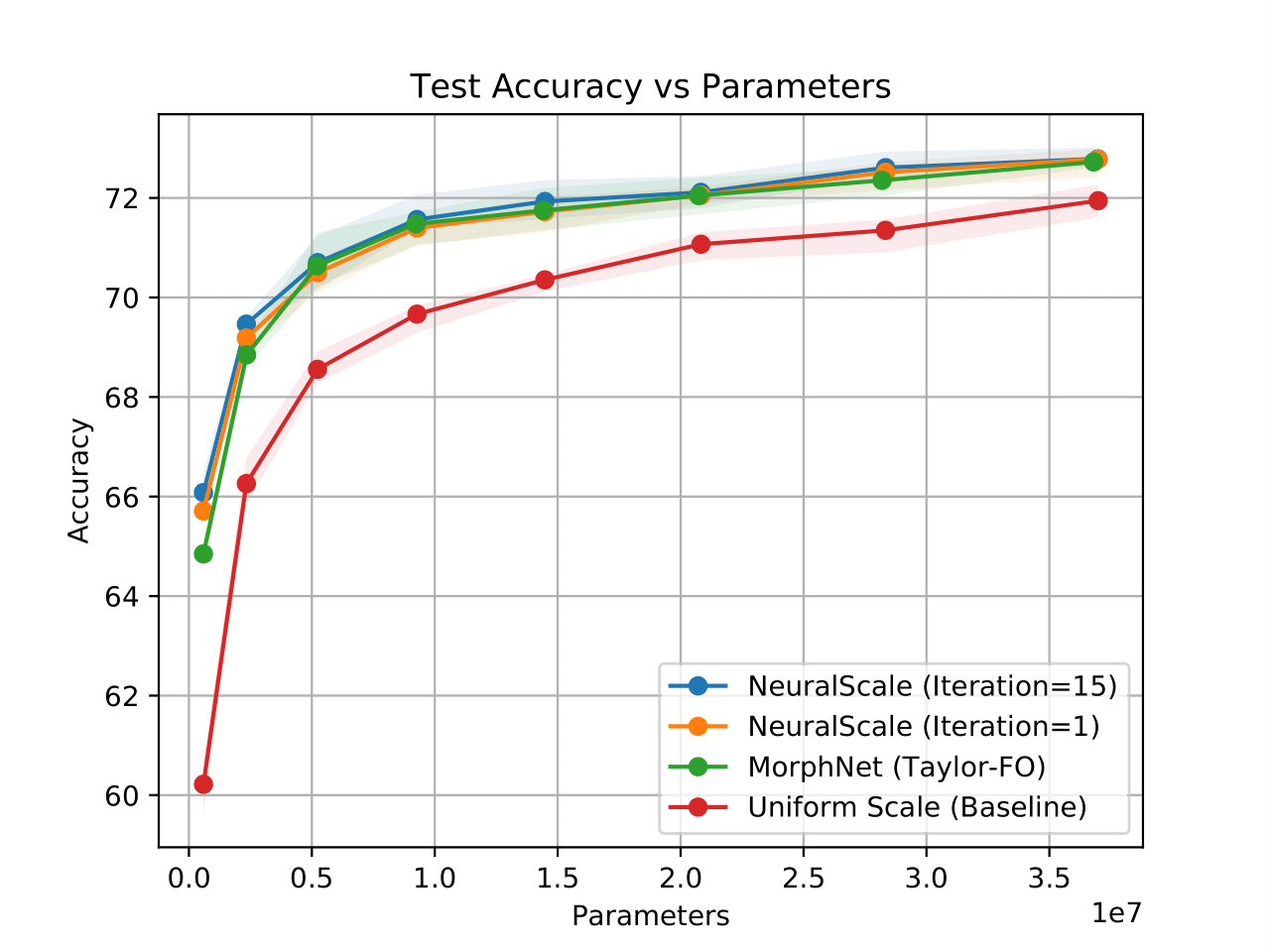 |
| MobileNetV2-CIFAR100 | MobileNetV2-TinyImageNet |
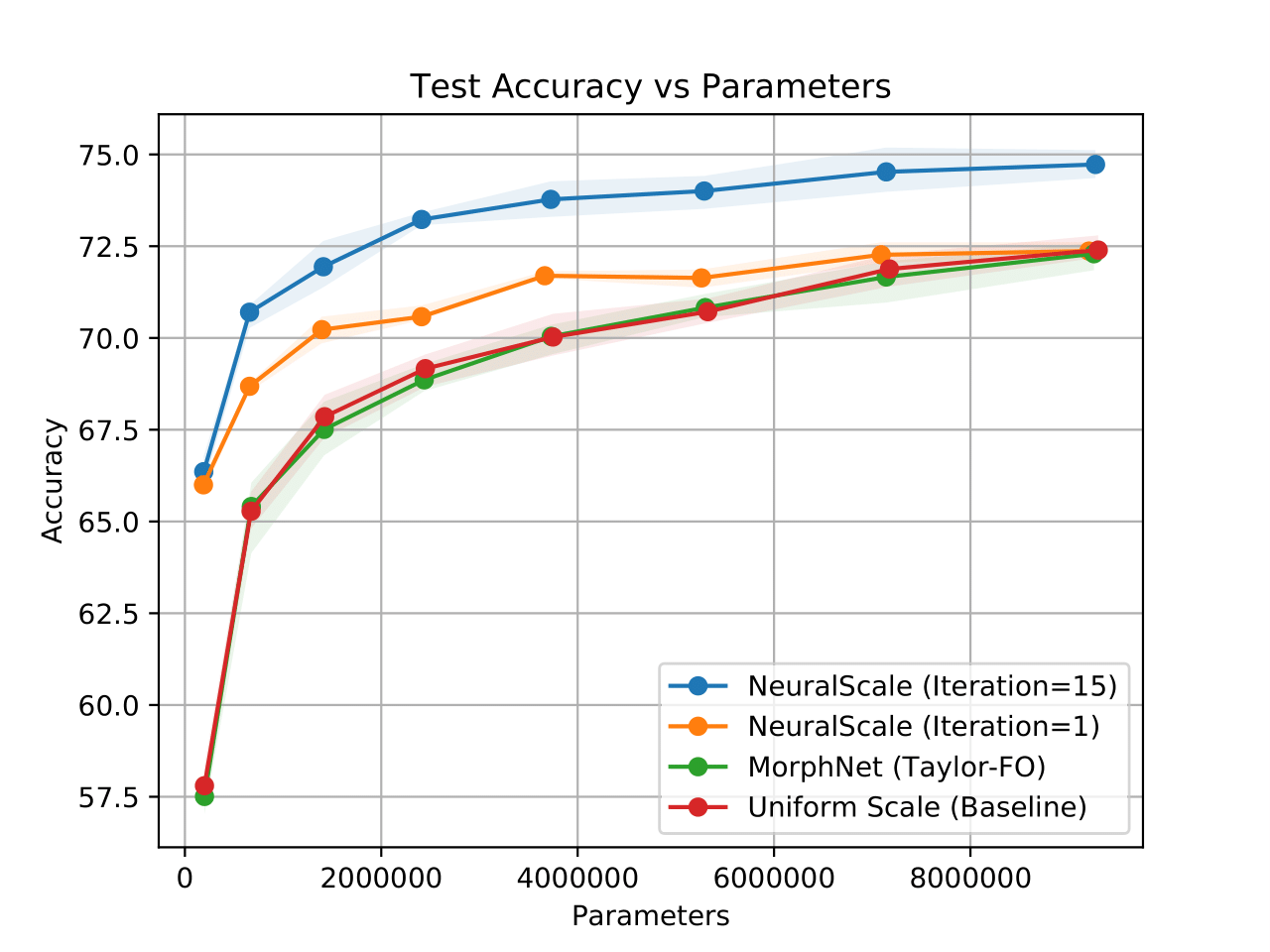 |
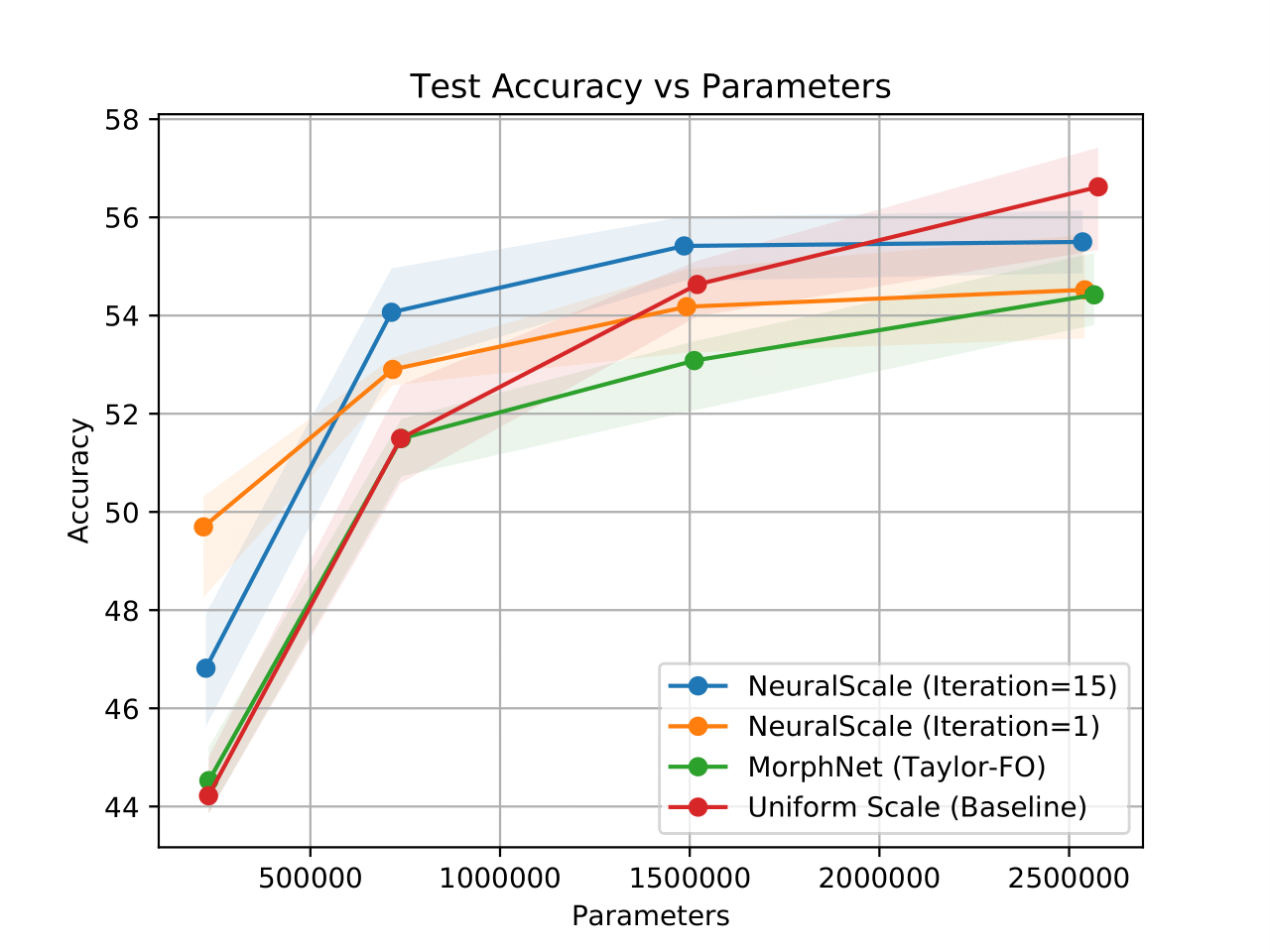 |
| ResNet18-CIFAR100 | ResNet18-TinyImageNet |
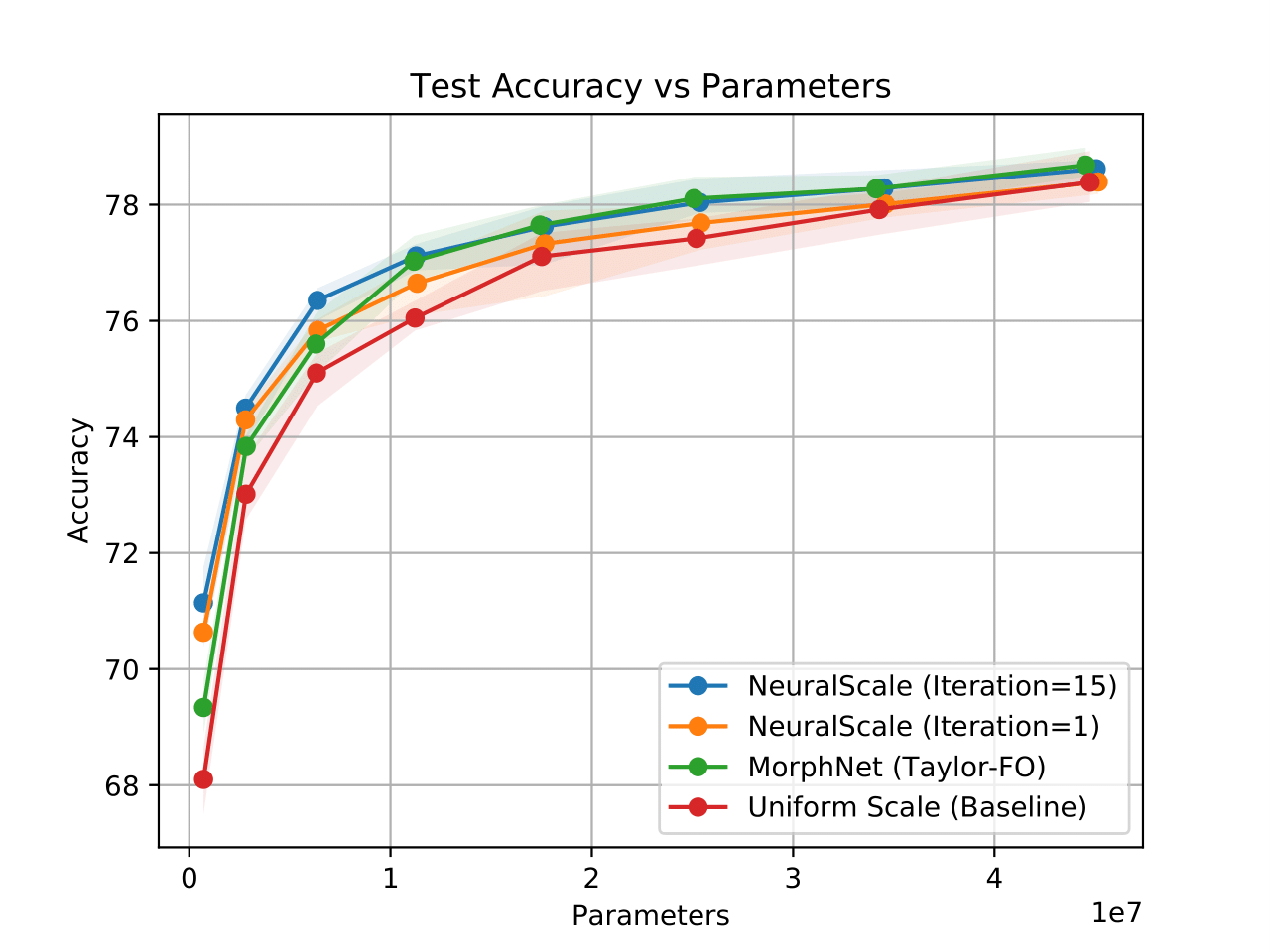 |
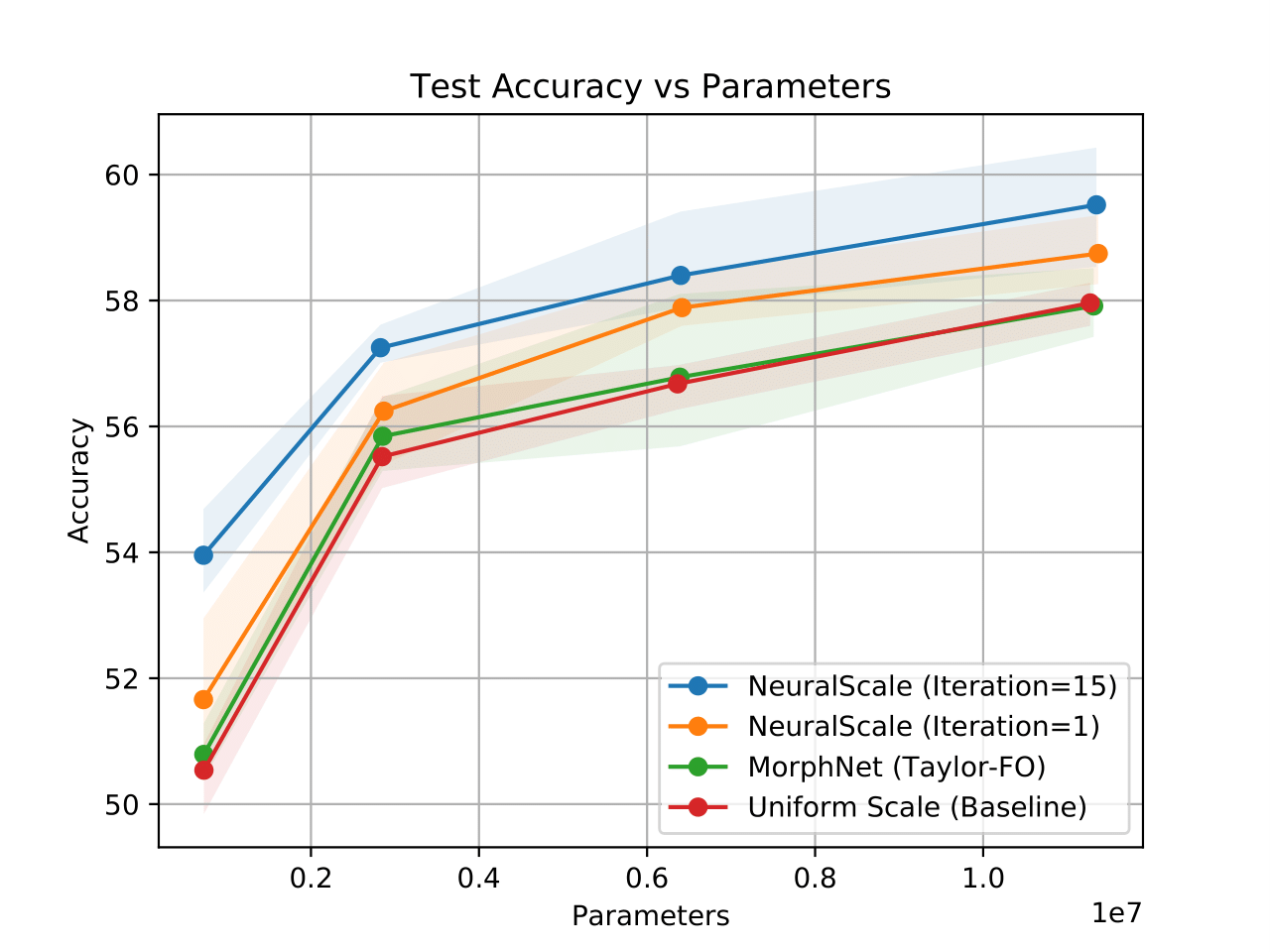 |
To show results that compare with the usage of convolutional shortcut instead of identity shortcut found in the supplementary section, run
python3 plot_ratio_warmup.py --model mobilenetv2 --dataset CIFAR100
Pruning based on weight magnitude is prepared by first running
python3 train_norm.py --model vgg --dataset CIFAR100 --save vgg_standard_c100
and is proceeded with
python3 fine_tune.py --model vgg --dataset CIFAR100 --prune_fname vgg_standard_c100 --save vgg_norm_c100_0
Results obtained via fine-tuning can be listed by running
python3 plot_ratio_finetune.py --model vgg --dataset CIFAR100
Empirical results on using different warm-up epochs before pruning can be plotted using (for MobileNetV2 on CIFAR100)
python3 plot_ratio_warmup.py --model mobilenetv2 --dataset CIFAR100
To show configuration obtained using architecture descent, run
python3 list_architecture.py --model vgg --dataset CIFAR100 --prune_fname filename
where filename should match the one specified for architecture_descent.py above.
Below are examples of configuration found using architecture descent:
| Model | Dataset | Configuration |
|---|---|---|
| VGG11 | CIFAR10 |  |
| VGG11 | CIFAR100 |  |
| MobileNetV2 | CIFAR100 |  |
| MobileNetV2 | TinyImageNet |  |
| ResNet18 | CIFAR100 |  |
| ResNet18 | TinyImageNet |  |
To show residual filters obtained via iterative pruning, run
python3 plot_filters.py --model vgg --dataset CIFAR100 --prune_fname filename
Below is an example for VGG11 using CIFAR10 and CIFAR100:
| VGG11-CIFAR10 | VGG11-CIFAR100 |
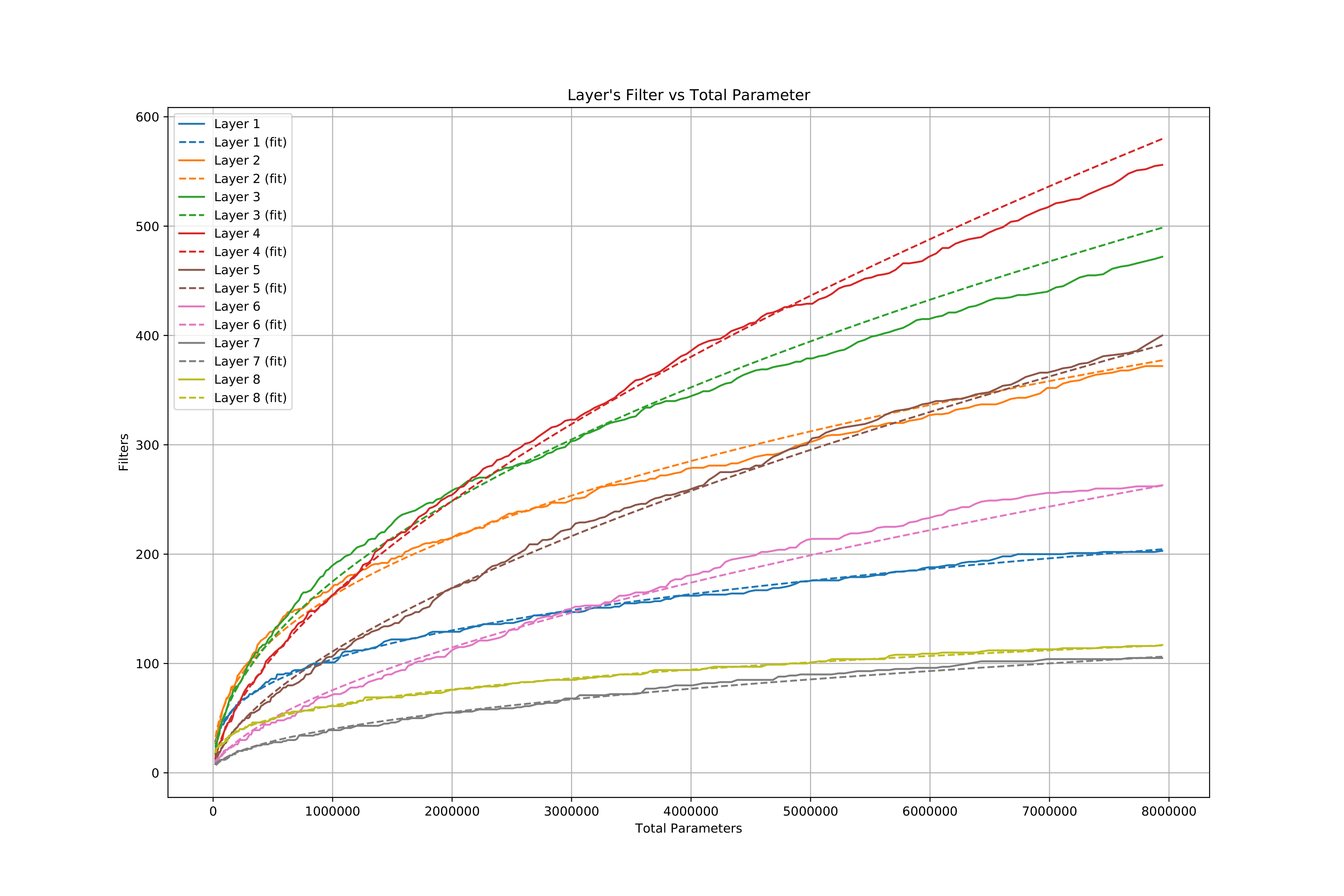 |
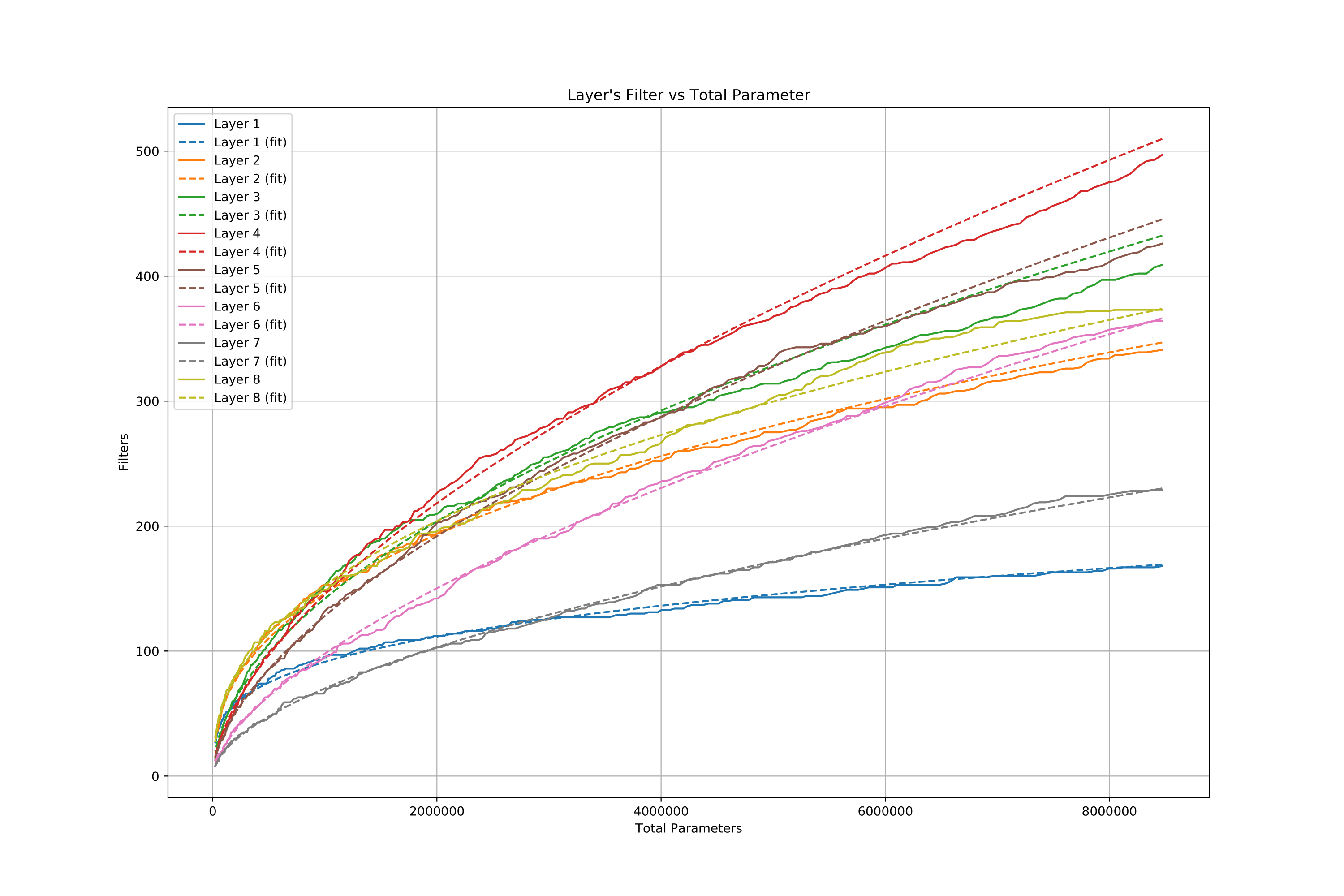 |
NeuralScale can be applied to various architecture where the implementation are as follows:
- Using
model/VGG.py,model/mobilenetv2.pyandmodel/preact_resnet.pyas an example, the functionprepare_filters()has to be modified for the targeted architecture - Gates are added after batch normaliztion layers (preferably)
- Modify and Run
architecture_descent.py - Voila! You get your optimized architecture configuration
If you find this code useful you can cite us using the following bibTex:
@inproceedings{lee2020neuralscale,
title={NeuralScale: Efficient Scaling of Neurons for Resource-Constrained Deep Neural Networks},
author={Lee, Eugene and Lee, Chen-Yi},
booktitle={Proceedings of the IEEE/CVF Conference on Computer Vision and Pattern Recognition},
pages={1478--1487},
year={2020}
}


